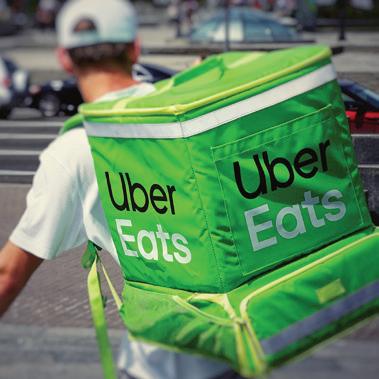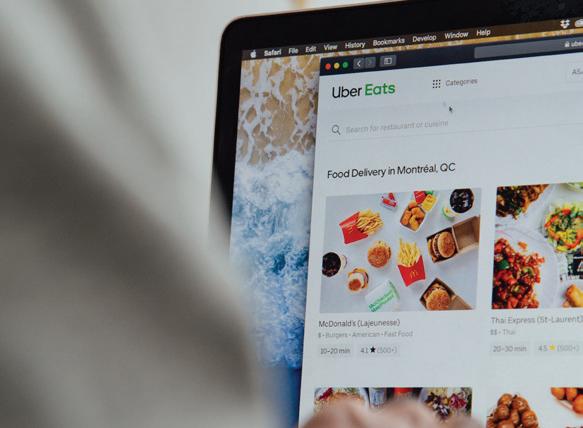
9 minute read
Shifting from dine-in to takeout
Photo by Sean Cooper for Eatery Pulse Media.
By Rick Zambrano
Advertisement
Restaurants embrace longstanding, increasingly-relevant best practices to bolster their chances of success amid COVID-19 outbreak
Amid the COVID-19 outbreak, restaurants have necessarily moved to delivery, drive-thru and curbside business only. As dining rooms have closed due to stay-at-home orders and protective ordinances in the Washington, D.C. Region, restaurateurs are fully focused on the takeout game. It’s an enormous shift for restaurants that typically have been accustomed to having only 5 to 20 percent of their sales derive from takeout. However, as we’re hearing around the DMV, restaurant owners are willing to take that gamble to keep businesses open.
Keeping restaurants open during the crisis may increase the likelihood they can remain open afterward. Restaurateurs equipped with solid financial knowledge are more likely to weather the full Coronavirus storm by giving heightened attention to food cost, labor leverage and technology services.
Following the right economics
Amir Mostafavi, founder and CEO of South Block Juice, a chain of nearly a dozen healthcentric juice and smoothie shops, recently expanded his relationship with Uber Eats so that all stores could take orders from the third-party delivery provider. As a multi-unit operator, Mostafavi applied this additional leverage to negotiate fees. In fact, restaurant chains and multi-unit restaurant companies have had access to more latitude on fees for quite some time. The same principle applies to additional delivery providers, such as DoorDash and Grubhub.
There’s a significant cost to package items for to-go usage, transport them where they need to go and also pay for the technology to support the process. Although third-party delivery companies provide a ready-to-launch model that restaurateurs can embrace quickly in these desperate times, these programs charge fees of as much as 30 percent, potentially rendering net sales unprofitable. By and large, restaurant profit margins hover around 10 to 15 percent. If a business chooses to operate exclusively in a third-party delivery format, it will be more likely to bleed cash.
Providing sharply-increased takeout and delivery service can present some disadvantages. There’s a significant cost to package items for to-go usage, transport them where they need to go and also pay for the technology to support the process. Although third-party delivery companies provide a ready-to-launch model that restaurateurs can embrace quickly in these desperate times, these programs charge fees of as much as 30 percent, potentially rendering net sales unprofitable. By and large, restaurant profit margins hover around 10 to 15 percent. If a business chooses to operate exclusively in a third-party delivery format, it will be more likely to bleed cash.
Knowing the economics and hard numbers of the business helps restaurant owners rise to the occasion. In D.C. and around the country, restaurants are finding creative ways to supply food to their communities while expanding their menus and focusing on more profitable sales. Companies like Great American Restaurants, a local, multi-brand operator, have continued to innovate. At Patsy’s for example, for $59.95, customers can pick up grocery kits containing 10 pantry staples, including chicken, butter, rice and toilet paper.
South Block Juice has been using its own staff to deliver its juices, as well as smoothie kits. The take-home kit includes enough acai and toppings for preparing six Acai Bowls at home, delivered straight to customers’ doors. Meanwhile, the store’s traditional menu is available for delivery through Uber Eats. Customers within 12 miles of the East Falls Church shop can access staff-powered delivery.
Communicating
When dining room closures due to COVID-19 became commonplace, local restaurants that had already forged communication channels with customers had a leg up. Although Gravitas, a fine-dining gem in D.C., did not yet have an established delivery and pick-up order system, its customers quickly received email notification that take-out/delivery service would be up and running soon. Many restaurants in the D.C. area were communicating enhanced cleaning and sanitation procedures to existing customers via email and social media.
South Block doubled its weekly customer email blasts and tripled its Instagram posts. Mostafavir knew it was crucial to inform customers his stores were open and take their customers’ health seriously. Keeping communication flowing is vital to the livelihood of any retail establishment. Early implementation of this practice that gave some restaurants a jump on the competition and increased exponentially their chances of being patronized.
Embracing safety
While many restaurants across the country have excelled at paying attention to safety and sanitation more than most other businesses, they are increasing their vigilance and stepping up communication about it during the COVID-19 outbreak. Customers need to be apprised of the enhanced action plans and
As COVID-19 continues to spread, restaurant owners have instituted more stringent policies around restaurant employees that show symptoms of illness. At South Block, in addition to other restaurants in the area, sick employees are not allowed to punch in for work. Mandatory face masks provide South Block staff, and by extension, customers an additional measure of safety. Restaurants and contact surfaces are cleaned every 30 minutes; a big digital clock reminds staff of these intervals. Keeping bathrooms open for customers and delivery drivers, including the Uber Drivers that pass through, allows the South Block extended family and clientele to wash hands and stop the spread of germs and viruses.
Leveraging technology
The COVID-19 health crisis and its impact on restaurants has brought an alreadypressing question into sharp focus: How are restaurants to stand out in a crowd when everyone is navigating the same virtual space? The answer is technology. A rapid evolution of technology seems to demand that restaurant owners get degrees in Information Technology. This is only a slight exaggeration; the National Restaurant Association, in its Restaurant Trends 2030 report, projected that there will be a greater need for college educated, tech-savvy professionals working within restaurants in the not-so-distant future.
Customers’ responses to evolving procedures of restaurants during the COVID-19 health crisis have made it clear that they are willing to continue buying. Restaurants can respond by leveraging technology to make customer ordering easier and more seamless. For many customers, phoning a restaurant is old-school, and waiting on hold is a time-waster. A report from foodservice consultancy Technomic and the National Restaurant Association, Harnessing Technology to Drive Off-Premises Sales, which we highlighted in a past issue, indicates that customers are ready to enjoy food at their pace and convenience, and streamlined takeout and delivery already play a big part in that.

Pre-COVID, 90 percent of customers already ordered takeout at least once per month and 79 percent requested delivery. Many restaurant owners haven’t kept pace with the demand for off-premises business. In addition, 35 percent of consumers were already saying they wanted to order delivery more often. One of the best components of off-premises sales success is online ordering technology, offered by vendors such as Square, ChowNow and restaurantdelivery.com.
Mobile and kiosk technology are additional streamlined ordering options, with the added benefit of less cash and fewer cards exchanging hands. With frequent, proper cleaning, kiosks may be less likely to spread germs than person-to-person contact.
“Cashless retail is also going to become the norm,” says Sam Zietz, chief executive of GRUBBRR, a technology company that supplies ordering technology, including kiosks. “Cash is the dirtiest item in restaurants and retailers, and frankly, fewer people are using cash because of the germs it may carry. Cash goes through many people’s hands and with COVID-19, everyone is becoming more aware of what they are touching.”
Mobile apps currently allow customers to order food without subjecting themselves to situations lacking social distancing. From the convenience of cars, customers can order and head to curbside pick-up areas that are now prevalent among the restaurants that are still operating. Custom restaurant ordering apps are highly under-used on the restaurant end of the equation. According to Harnessing Technology, 43 percent of delivery users order food via restaurant apps, but only 18 percent of restaurants offer such apps. What’s more,

Delivery is a major way customers are enjoying restaurant food during the pandemic.
Photo by Victor Aldabalde.
56 percent of consumers order food online via websites, but only 45 percent of restaurants offer this convenience. Now more than ever, restaurants are best served by using technology to let customers order food in the way they want.
For curbside convenience, companies like GRUBBRR offer mobile kiosks that can be placed outside restaurants. “GRUBBRR works with many quick service restaurants and we’ve seen some of them are beginning to use technology in unique ways,” notes Zietz. “Many of the restaurants that already relied on our kiosks are now taking those ordering kiosks and putting them outside…. We also recognize that people may be afraid to touch kiosks due to germs, so last week we rolled out a contactless feature where people can use their phones and QR codes for hands-free ordering.”
Packaging to make a difference
The best packaging has always won the hearts of consumers. Food delivered hot and ingredients that stay separate during travel to customers’ homes win the loyalty of customers. Now, during the current health crisis, customers are looking for safety in packaging of the food they pick up or have delivered. More than ever, “tamper-evident” seals and packaging that keeps food hot and intact are critical to success.
Branding also matters. When customers order from P.F. Chang’s each order comes in a branded bag with branded napkins. Packaging is an extension of each brand. In these worrisome times, it’s even more critical for restaurants to both reassure customers with their company’s safety precautions, and remind them of the value proposition of their brand. South Block, for example, insists that their own branded bags hold the orders that go out with Uber Eats.
Third-party delivery companies have been aggressive in promoting their own brands. But restaurants are best served by establishing a direct connection with customers, letting them know they are not a commodity, but a brand with specific advantages. In many cases, a delivery order might be the first introduction to a particular restaurant. Including branded packaging and special offers with a delivery order is critical. Restaurants can help remind customers of where the food is prepared and its safety (thus tamper-evident seals currently being used to show food hasn’t been touched.)
Summing it up
Off-premises business is challenging to manage successfully under normal circumstances. During the current COVID-19 crisis, it’s even harder. Some of the best practices that top restaurants have embraced over time hold even more meaning today: a deep understanding of a restaurant’s economics, communication with the customer, leveraging technology, using great packaging ensure a successful outcome. The end results should be that food is delivered safely, with a smile, and hot/ready to eat.
During the health crisis, additional best practices have emerged to the forefront: detailed attention to and communication about safety and sanitation; and a healthy workplace where employees are safe and can prepare safe meals. Operating a restaurant at 20 or 30 percent of customary sales is by no means easy. In our current takeout-only and virus-threatened environment, restaurants can use these principles, guidelines and tools to survive and best serve their customers and communities.

Mobile, online ordering for pick-up and delivery has become critical.
Photo by Charles Deluvin



